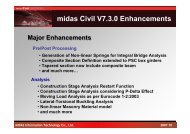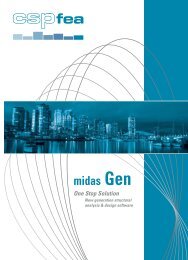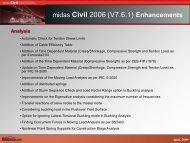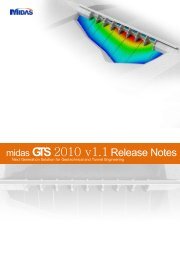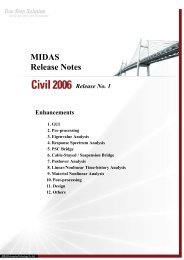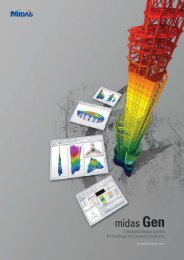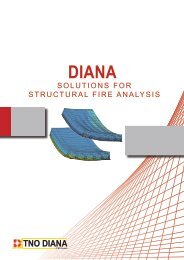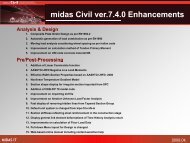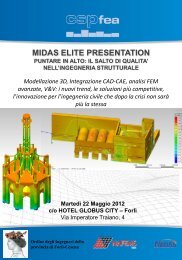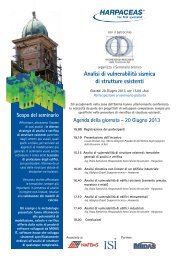Gen 2011 (v1.1) Release Note - CSP Fea
Gen 2011 (v1.1) Release Note - CSP Fea
Gen 2011 (v1.1) Release Note - CSP Fea
You also want an ePaper? Increase the reach of your titles
YUMPU automatically turns print PDFs into web optimized ePapers that Google loves.
<strong>Gen</strong> <strong>2011</strong> (<strong>v1.1</strong>) <strong>Release</strong> <strong>Note</strong>Integrated Design System for Building and <strong>Gen</strong>eral Structures
Enhancements• New module1. <strong>Gen</strong>eral Section Designer3• Pre/Post Processing161. Addition of Header and Footer in DynamicReport2. Midas Link for Revit Structure <strong>2011</strong>3. Plate Member Data in the Model Data TextOutputand much more…• Analysis1. Pushover analysis enhancement1) Lateral load pattern as per N2 method2) Target displacements as per NTC 20083) Safety Verification as per NTC 20084) Enhanced Safety verification Table2. Damping Ratios by Material Properties3. Considering Consistent Mass in Time HistoryAnalysisand much more…22• Design1. Enhancement in Strong Column-Weak BeamDesign as per TWN-USD9241
New Module1. <strong>Gen</strong>eral Section Designer
<strong>Gen</strong> <strong>2011</strong>New module (GSD)<strong>Gen</strong> <strong>2011</strong> (<strong>v1.1</strong>) <strong>Release</strong> <strong>Note</strong>1. <strong>Gen</strong>eral Section Designer (GSD)<strong>Gen</strong>eral Section Check or GSD is a new module added to midas Civil/<strong>Gen</strong>.Scope of GSD:• Definition of any irregular cross-section• Calculation of Section properties• <strong>Gen</strong>eration of P-M, P-My-Mz, M-M interaction curves• Calculation of Section Capacity (in flexure) and Safety Ratio based on member forces.• <strong>Gen</strong>eration of Moment-Curvature curve.• Plot of Stress contours for all the cross-sections.All the above features are supported for: RC sections, Steel sections and Composite sections.Work processStress Contour3D PM Interaction curveMoment- Curvature4 /43
<strong>Gen</strong> <strong>2011</strong>New module (GSD)<strong>Gen</strong> <strong>2011</strong> (<strong>v1.1</strong>) <strong>Release</strong> <strong>Note</strong>User Interface• GSD can be called from midas <strong>Gen</strong> by Tools > <strong>Gen</strong>eral Section Designer.• In one model file, more than one section can be created and saved under different names.• All the sections are listed in the Works Tree.• Double click the section name in the Works Tree to show the section in the section view .Main menuWorks TreeToolbarSection ViewTable WindowCoordinatesMessage WindowUnit Control5 /43
<strong>Gen</strong> <strong>2011</strong>New module (GSD)<strong>Gen</strong> <strong>2011</strong> (<strong>v1.1</strong>) <strong>Release</strong> <strong>Note</strong>Work ProcessStep 1. Define material• Materials : RC, Steel.• Applied Codes: Eurocode, UNI, British Standard, ASTM, Indian Standard, etc.• Nonlinear material properties can also be assigned to concrete, structural steel and rebarmaterials.6 /43
<strong>Gen</strong> <strong>2011</strong>New module (GSD)<strong>Gen</strong> <strong>2011</strong> (<strong>v1.1</strong>) <strong>Release</strong> <strong>Note</strong>Work ProcessStep 1. Define material• Nonlinear Material Properties• Concrete nonlinear propertiesParabolic Stress-strain Curve• Steel nonlinear propertiesKent & Park ModelMenegotto-Pinto ModelAsymmetrical Bi-linear Curve7 /43
<strong>Gen</strong> <strong>2011</strong>New module (GSD)<strong>Gen</strong> <strong>2011</strong> (<strong>v1.1</strong>) <strong>Release</strong> <strong>Note</strong>Work ProcessStep 2. Define cross-section– Basic shape section by selecting a section from the DB of the standard sections for acountry– Any irregular cross-section by specifying the shape in the Section View or enteringcoordinates into a tableModel > Shape > Basic Shape<strong>Gen</strong>eral type shape8 /43
<strong>Gen</strong> <strong>2011</strong>New module (GSD)<strong>Gen</strong> <strong>2011</strong> (<strong>v1.1</strong>) <strong>Release</strong> <strong>Note</strong>Work ProcessStep 2. Define cross-section– Merging two shapes– Creating hollow sectionsModel > Shape > Merge ShapeCopy ShapesMerged ShapesCreating Hollow Section9 /43
<strong>Gen</strong> <strong>2011</strong>New module (GSD)<strong>Gen</strong> <strong>2011</strong> (<strong>v1.1</strong>) <strong>Release</strong> <strong>Note</strong>Work ProcessStep 3.1 Select Rebar Material• The following stress-strain curves can be assigned to rebars.– Elastic-Only– Bilinear Model– Menegotto-Pinto Model– Park Strain HardeningModel > Rebar > Rebar MaterialBilinear ModelPark Strain HardeningMenegotto-Pinto Model10 /43
<strong>Gen</strong> <strong>2011</strong>New module (GSD)<strong>Gen</strong> <strong>2011</strong> (<strong>v1.1</strong>) <strong>Release</strong> <strong>Note</strong>Work ProcessStep 3.2 Add Rebars: Various patterns are available for assigning the rebars to a section.– Point pattern : Add rebar at a single point.– Line Pattern : Add rebars in a line.– Arc Pattern : Add rebars in a circular arc patterns.– Rectangular Pattern : Add rebars in a rectangular pattern.– Perimeter pattern : Add rebars around the outer perimeter of the section byspecifying the concrete cover and number of rebars.Model > Rebar > Rebar-Point Pattern…11 /43
<strong>Gen</strong> <strong>2011</strong>New module (GSD)<strong>Gen</strong> <strong>2011</strong> (<strong>v1.1</strong>) <strong>Release</strong> <strong>Note</strong>Work ProcessStep 4. Define Load Combinations and member forcesSign Convention:• Clockwise moment about the y and z axes are taken as positive. Anti-clockwise momentsare taken as negative. P is taken as positive towards ‘+z’ axis.Step 5. Cross-section Properties:• Apart from general section properties, Principal Properties, Section Modulus & Plasticproperties are also calculated.Model > Define Load CombinationModel > Section Property12 /43
<strong>Gen</strong> <strong>2011</strong>New module (GSD)<strong>Gen</strong> <strong>2011</strong> (<strong>v1.1</strong>) <strong>Release</strong> <strong>Note</strong>Work ProcessStep 6.1 Check Results: Interaction CurvesResult > Interaction curveP-M interaction curve for a specified angleP-M interaction curve for a Load Combination13 /43
<strong>Gen</strong> <strong>2011</strong>New module (GSD)<strong>Gen</strong> <strong>2011</strong> (<strong>v1.1</strong>) <strong>Release</strong> <strong>Note</strong>Work ProcessStep 6.1 Check Results: Interaction CurvesResult > Interaction curveM-M interaction curve for a Load combination3 D interaction surface showing all the load combination14 /43
<strong>Gen</strong> <strong>2011</strong>New module (GSD)<strong>Gen</strong> <strong>2011</strong> (<strong>v1.1</strong>) <strong>Release</strong> <strong>Note</strong>Work ProcessStep 6.2 Check Results: Moment-curvature curveStep 6.3 Check Result: Stress ContourResult > Moment Curvature CurveMove mouse pointer onthe curve to see thestrain diagram at aparticular point.Result > Stress ContourMoment-curvature curveStress contours15 /43
List of Detailed Enhancements in Pre & Post Processing1. Addition of Header and Footer in Dynamic Report2. Midas Link for Revit Structure <strong>2011</strong>3. Plate Member Data in the Model Data Text Output4. Easy access to the Time History Result Tables5. Warning Message for the Changes in the Story Data
<strong>Gen</strong> <strong>2011</strong> Pre & Post-processing <strong>Gen</strong> <strong>2011</strong> (<strong>v1.1</strong>) <strong>Release</strong> <strong>Note</strong>1. Addition of Header and Footer in Dynamic ReportIn the dynamic report, we can add the project Information in the header and footer of MSWord. Project Information includes Project Name, Revision, User Name, E-mail, Address,Telephone, Fax, Client, Title, File Name, Created, Directory, Modified, and File Size.Procedure of Header and Footer <strong>Gen</strong>eration1. Fill out the Project Information in the File tab.2. Open the Dynamic Report and double click Header and Footer in the Report Tree.3. Select the items to add or remove in the header or footer field by clicking arrow buttons.4. Use up and down arrows to arrange the order of header and footer items.5. Click OK button to confirm.Tools > Dynamic Report <strong>Gen</strong>erator17 /43
<strong>Gen</strong> <strong>2011</strong> Pre & Post-processing <strong>Gen</strong> <strong>2011</strong> (<strong>v1.1</strong>) <strong>Release</strong> <strong>Note</strong>2. Midas Link for Revit Structure <strong>2011</strong>Midas Link for Revit Structure <strong>2011</strong> is now available to transfer a Revit model data to midas<strong>Gen</strong>, and delivery back to Revit model files. It is provided as an Add-In module in RevitStructure and midas <strong>Gen</strong> text file(*.mgt) is used for the roundtrip.Midas Link for Revit Structure supports the following workflows1. Send the Revit Structure analytical model to midas <strong>Gen</strong>2. Import the MGT file of the Revit model in midas <strong>Gen</strong>3. Export the midas model file to the MGT file4. Update the Revit Structure model from midas <strong>Gen</strong>Tools > Dynamic Report <strong>Gen</strong>erator18 /43
<strong>Gen</strong> <strong>2011</strong> Pre & Post-processing <strong>Gen</strong> <strong>2011</strong> (<strong>v1.1</strong>) <strong>Release</strong> <strong>Note</strong>3. Plate Member Data in the Model Data Text Output• Now ‘Plate Member Data’ can viewed in the Model Data Text Output.• File > Model Data Text Output > Plate Member Data19 /43
<strong>Gen</strong> <strong>2011</strong> Pre & Post-processing <strong>Gen</strong> <strong>2011</strong> (<strong>v1.1</strong>) <strong>Release</strong> <strong>Note</strong>5. Easy Access to the Time History Result Tables• Time History Result Tables have been added to the Context Menu for improvedaccessibility.• Context Menu > Time History Results > Inelastic Hinge Table / Time History Analysis TableDisp./Vel./Accel. TableBeam Force Table20 /43
<strong>Gen</strong> <strong>2011</strong> Pre & Post-processing <strong>Gen</strong> <strong>2011</strong> (<strong>v1.1</strong>) <strong>Release</strong> <strong>Note</strong>6. Warning Message for the Changes in the Story Data• A warning message is displayed notifying that the number of stories being considered isnot in agreement with the generated data.• Model > Building > Story• After Story Data generationwhen a node is moved (the node where a story is assigned is edited)when a story is addedwhen a story is divided• The following message will be displayed when executing Perform Analysis21 /43
List of Detailed Enhancements in Analysis1. Pushover analysis enhancement1) Lateral load pattern as per N2 method2) Target displacements as per NTC 20083) Safety Verification as per NTC 20084) Enhanced Safety verification Table2. Damping Ratios by Material Properties3. Considering Consistent Mass in Time History Analysis4. Improvement in Group Damping5. Considering Static Load Case for the Initial Loading inTime History Analysis6. Considering the Construction Stage Load for InitialLoading in Pushover Analysis7. Option for cumulating reactions and displacementsdue to initial loads in Pushover Analysis8. Considering Boundary Change Assignment Functionin Pushover Analysis9. Option for Considering the Shear Failure in PushoverAnalysis10. Improvement in Pushover Hinge Properties with SRCSections11. Addition of Ramberg-Osgood and Hardin-DrnevichModels in Inelastic Hinge Property
<strong>Gen</strong> <strong>2011</strong>Analysis<strong>Gen</strong> <strong>2011</strong> (<strong>v1.1</strong>) <strong>Release</strong> <strong>Note</strong>1. Pushover analysis enhancement1) Lateral load pattern as per N2 method• The N2 method implements a new load pattern Normalized Mode Shape *Pushover analysis.Mass forDesign > Pushover Analysis > Pushover Load Case23 /43
<strong>Gen</strong> <strong>2011</strong>Analysis<strong>Gen</strong> <strong>2011</strong> (<strong>v1.1</strong>) <strong>Release</strong> <strong>Note</strong> Normalization of mode shape• Eigenvalue analysis is performed to obtain the mode shape for pushover analysis on astructure. In midas <strong>Gen</strong>, the mode shapes are normalized in such way that Φn=1, where n isthe user defined master node , generally at the roof level.• Pushover analysis is complete when the displacement of the master node reaches thespecified maximum displacement. The lateral loads are applied at the centre of mass of eachstorey and the lateral load pattern is obtained by the normalized Ф values of centre of mass.• The mode shape values of a structure, at the center of mass, are specified in the table alongwith the normalized values.User-Defined Master NodeRoof.8713F2F1F.54.21.65.63.24.74Model Mode Shape Normalized Mode ShapeNormalization of Mode ShapeStoryMode ShapeФNormalized Mode Shape ФRoof .87 13F .65 .742F .54 .631F .21 .2424 /43
<strong>Gen</strong> <strong>2011</strong>Analysis<strong>Gen</strong> <strong>2011</strong> (<strong>v1.1</strong>) <strong>Release</strong> <strong>Note</strong> Lateral Load Pattern• In order to generate pushover curves, lateral load patterns are required. If floordiaphragms are assigned, lateral loads are applied at the center of mass per story. If floordiaphragms are not assigned, lateral loads are applied at the location of the masses in themodel automatically.• The pushover load is applied up to the point when the displacement of master nodereaches the maximum displacement.• The lateral load patterns are obtained by normalized mode shape and Story mass factor.m 4 = 400Roof11m 3 = 3003F.74.55m 2 = 2002F.63.31m 1 = 1001F.24.06ModelNormalized Mode ShapeLoad PatternLateral Load PatternStoryStory MassNormalized Mode Shape, ФCalculationLoad FactorRoof 400 1 (1X400)/(1X400) 13F 300 .74 (.74X300)/(1X400) .552F 200 .63 (.63X200)/(1X400) .311F 100 .24 (.24X100)/(1X400) .0625 /43
<strong>Gen</strong> <strong>2011</strong>Analysis<strong>Gen</strong> <strong>2011</strong> (<strong>v1.1</strong>) <strong>Release</strong> <strong>Note</strong> Gamma Calculation• Transformation factor Gamma is calculated based on the following two methods:o 2D Behavior (EC8-1:2004 Annex B)o 3D Behavior• 2D Behavior is based on EC8 -1 :2004 Annex B and determines the value of gamma by onlyconsidering the direction in which pushover analysis is performed . Hence the value ofgamma is :• 3D Behavior determines the gamma by considering lateral deflection in all the possibledirections :Design > Pushover Analysis > Pushover CurveDesign > Pushover Analysis > Pushover Curve26 /43
<strong>Gen</strong> <strong>2011</strong>Analysis<strong>Gen</strong> <strong>2011</strong> (<strong>v1.1</strong>) <strong>Release</strong> <strong>Note</strong>2) Target displacements as per NTC 2008• Target displacements are defined as the seismic demand derived from the elastic responsespectrum in terms of the displacement of an equivalent SDOF system. Target displacementsfor the limit states SLO, SLD, SLC and SLV are automatically calculated as per NTC2008.Different spectrums can be assigned to different limit states for determining the demand.Design > Pushover Analysis > Pushover CurveSelect spectrum for differentSelect spectrum for differentSelect spectrum limit states for differentSelect spectrum limit states for differentlimit stateslimit statesMethod of Gamma Calculation Target displacements and corresponding pushover stepsTarget displacements and corresponding pushover stepsMethod of Gamma Calculation Target displacementsTarget displacementsand correspondingand correspondingpushoverpushoverstepssteps27 /43
<strong>Gen</strong> <strong>2011</strong>Analysis<strong>Gen</strong> <strong>2011</strong> (<strong>v1.1</strong>) <strong>Release</strong> <strong>Note</strong>3) Safety Verification as per NTC 2008 Global verification ( = Limitation of interstory drift)• The interstory drift demands from pushover analysis should not exceed the correspondingcapacities. Global verification is performed for the limit states SLO and SLD.• Interstory drift limit values are:- SLD: 0.005h, SLO: 0.005h x 2/3, where h is the story height.• The interstory drift demands are represented by target displacements for SLD and SLO. Thecapacities for SLD and SLO are determined by the roof displacements when maximuminterstory drift is equal to its limit values, 0.005h and 0.005h x 2/3, respectively.Design > Pushover Analysis > Pushover CurveDemand and capacity table28 /43
<strong>Gen</strong> <strong>2011</strong>Analysis<strong>Gen</strong> <strong>2011</strong> (<strong>v1.1</strong>) <strong>Release</strong> <strong>Note</strong> Local verificationThe local ductility and deformation demands from pushover analysis should not exceed thecorresponding capacities which implies that brittle elements should remain in the elasticregion. Local verification is performed for the limit states SLD, SLV and SLC. The capacities aredetermined as shown in the table below. The demand (rotation or shear force) for a member isobtained from the pushover step which is nearest to the target displacement for thecorresponding limit states.Design > Pushover Analysis > Pushover Hinge Result Table > Safety Verification TableDemand and capacity table29 /43
<strong>Gen</strong> <strong>2011</strong>Analysis<strong>Gen</strong> <strong>2011</strong> (<strong>v1.1</strong>) <strong>Release</strong> <strong>Note</strong>4) Enhanced Safety verification Table• Capacity values for different limit states can be viewed with user defined steps.Design > Pushover Analysis > Pushover Hinge Result Table > Safety Verification TableCapacity values30 /43
<strong>Gen</strong> <strong>2011</strong>Analysis<strong>Gen</strong> <strong>2011</strong> (<strong>v1.1</strong>) <strong>Release</strong> <strong>Note</strong>2. Damping Ratios by Material Properties• An option considering different damping ratios for different materials has been added inthe Material Data for time history analysis and response spectrum analysis.• In order to apply the damping ratio specified in the Material Data, following dampingmethod needs to be selected in the Time History Load Cases.Response Spectrum Analysis : Strain Energy ProportionalTime History Analysis: Element Mass & Stiffness Proportional or Strain Energy Damping• Load > Time History Analysis Data > Time History Load Cases• Model > Properties > Material > Add > Damping RatioDefault value of damping ratio by material types- Steel : 0.02 (2%)- Concrete / SRC : 0.05 (5%)- USER : 0.00 (0%)31 /43
<strong>Gen</strong> <strong>2011</strong>Analysis<strong>Gen</strong> <strong>2011</strong> (<strong>v1.1</strong>) <strong>Release</strong> <strong>Note</strong>3. Considering Consistent Mass in Time History Analysis• Now Consistent Mass and Off-diagonal Masses option of Lumped Mass can beconsidered during the linear and nonlinear time history analysis. In the previousversions, ‘Lumped Mass’ could be applied only when selecting the ‘Off-diagonal Masses’option in the time history analysis.• If the Consistent Mass or Off-diagonal Mass option is used, Lanczos method should beused for Eigenvalue Analysis.• Model > Structure TypeConsistent MassMass Offset (Off-diagonal Masses)32 /43
<strong>Gen</strong> <strong>2011</strong>Analysis<strong>Gen</strong> <strong>2011</strong> (<strong>v1.1</strong>) <strong>Release</strong> <strong>Note</strong>4. Improvement in Group Damping• Group Damping dialog box has been divided into ‘Element Mass & StiffnessProportional…’ and ‘Strain Energy Proportional…’.• Now Mass Coefficient (alpha) can be considered. Coefficients for mass and stiffness(alpha and beta) are automatically calculated.• Model > Properties > Group Damping : Element Mass & Stiffness Proportional• Model > Properties > Group Damping : Strain Energy PropotionalElement Mass & Stiffness ProportionalStrain Energy Proportional33 /43
<strong>Gen</strong> <strong>2011</strong>Analysis<strong>Gen</strong> <strong>2011</strong> (<strong>v1.1</strong>) <strong>Release</strong> <strong>Note</strong>5. Considering Static Load Case for the Initial Loading in Time History Analysis• Now Static Analysis Result ‘Import (ST)’ can be considered as an initial load.• In the previous versions, the axial force due to ‘ST’ initial load was not reflected whendetermining yielding of the hinge. In the new version, the axial force due to ‘ST’ initial load isreflected when calculating the yield strength of moment component.• When ‘Increment Method>Load Control’ is used, ‘Time History Load Cases>Scale Factor’ is nowreflected.•Load > Time History Analysis Data > Time History Load Cases34 /43
<strong>Gen</strong> <strong>2011</strong>Analysis<strong>Gen</strong> <strong>2011</strong> (<strong>v1.1</strong>) <strong>Release</strong> <strong>Note</strong>6. Considering the Construction Stage Load for Initial Loadingin Pushover Analysis• Final stage member forces from construction stage analysis can be used as initial loadsfor the pushover analysis.• Pushover Analysis > Pushover Analysis Control35 /43
<strong>Gen</strong> <strong>2011</strong>Analysis<strong>Gen</strong> <strong>2011</strong> (<strong>v1.1</strong>) <strong>Release</strong> <strong>Note</strong>7. Option for cumulating reactions and displacements due to initial loadsin Pushover Analysis• In the previous versions, reactions due to initial loads were cumulative whereasdisplacements due to initial loads were not cumulative.• Now the user can choose whether to cumulate reactions/displacements due to initialloads or not.• Design > Pushover Analysis > Pushover Analysis > Pushover Load Cases• In the previous versions, the results due toinitial loads wereFor Reaction/Story shear: cumulativeFor Displacement: not cumulative• When the initial load filed is displayed as‘Import ST/CS Result’, this option is notavailable.<strong>Note</strong> that the results from the new versionmay not be the same as that from theprevious version of midas <strong>Gen</strong> because ofthis option.36 /43
<strong>Gen</strong> <strong>2011</strong>Analysis<strong>Gen</strong> <strong>2011</strong> (<strong>v1.1</strong>) <strong>Release</strong> <strong>Note</strong>8. Considering Boundary Change Assignment Function in Pushover Analysis• This function can be applied to the following condition:- When the boundary condition of the initial loading is different from that of the pushover loading- When the section stiffness scale factor assigned for the initial loading is different from that of thepushover loading• Analysis > Boundary Change Assignment to Load Cases/Analyses37 /43
<strong>Gen</strong> <strong>2011</strong>Analysis<strong>Gen</strong> <strong>2011</strong> (<strong>v1.1</strong>) <strong>Release</strong> <strong>Note</strong>9. Option for Considering the Shear Failure in Pushover Analysis• New option for considering the shear component failure has been newly added. When theoption is selected, the analysis will be automatically terminated if the shear hinge occurs in theselected member type.• Design > Pushover Analysis > Pushover Global Control38 /43
<strong>Gen</strong> <strong>2011</strong>Analysis<strong>Gen</strong> <strong>2011</strong> (<strong>v1.1</strong>) <strong>Release</strong> <strong>Note</strong>10. Improvement in Pushover Hinge Properties with SRC Sections• Pushover hinge properties can be calculated automatically for the following SRC sections: Rect-Cross I / Rect –Combined T / SRC-BOX-Stiffener / SRC-Pipe-Stiffener• Design > Pushover Analysis > Define Hinge Properties39 /43
<strong>Gen</strong> <strong>2011</strong>Analysis<strong>Gen</strong> <strong>2011</strong> (<strong>v1.1</strong>) <strong>Release</strong> <strong>Note</strong>11. Addition of Ramberg-Osgood and Hardin-Drnevich Modelsin Inelastic Hinge Property• Inelastic Hinge Properties can be defined with the Ramberg-Osgood and Hardin-Drnevich models and applied for inelastic time history analysis for soil.• Model > Properties > Inelastic Hinge PropertiesRamberg-Osgood, Hardin-Drnevich HysteresisCurve40 /43
List of Detailed Enhancements in Design1. Enhancement in Strong Column-Weak Beam Design asper TWN-USD92
<strong>Gen</strong> <strong>2011</strong>Design<strong>Gen</strong> <strong>2011</strong> (<strong>v1.1</strong>) <strong>Release</strong> <strong>Note</strong>1. Enhancement in Strong Column-Weak Beam Design as per TWN-USD92• A new option for Strong Column-Weak Beam design has been added.• In the previous version, beam design strength (Φ b M nb ) calculated the design flexuralmember force in column. In the new version, the design strength (Φ b M nb ) or thenominal strength (Φ b M nb ) can be considered.• Design > RC Strong Column Weak Beam Design > Ductile Design• Design > RC Strong Column Weak Beam Design > Strong Column Weak Beam Ratio• Design > RC Strong Column Weak Beam Design > Strong Column Weak Beam Ratio Table42 /43
<strong>Gen</strong> <strong>2011</strong>Design<strong>Gen</strong> <strong>2011</strong> (<strong>v1.1</strong>) <strong>Release</strong> <strong>Note</strong>•Ductile DesignDesign > RC Strong Column Weak Beam Design > Ductile DesignConcrete Code Design > Beam Design, Column DesignConcrete Code Check > Beam Checking, Column CheckingWhen Design Strength is selectedWhen Nominal Strength is selected•Strong Column Weak Beam RatioDesign > RC Strong Column Weak Beam Design > Strong Column Weak Beam RatioWhen Design Strength is selectedWhen Nominal Strength is selected43 /43



